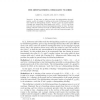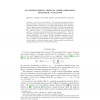751 search results - page 1 / 151 » The Distinguishing Chromatic Number |
DM
2010
13 years 4 months ago
2010
A labeling of a graph G is distinguishing if it is only preserved by the trivial automorphism of G. The distinguishing chromatic number of G is the smallest integer k such that G ...
COMBINATORICS
2006
13 years 4 months ago
2006
SIAMDM
2010
13 years 2 months ago
2010
JCT
2008
13 years 4 months ago
2008
Let T be an unrooted tree. The chromatic symmetric function XT , introduced by Stanley, is a sum of monomial symmetric functions corresponding to proper colorings of T . The subtre...
COMBINATORICS
2007
13 years 4 months ago
2007
The distinguishing number ∆(X) of a graph X is the least positive integer n for which there exists a function f : V (X) → {0, 1, 2, · · · , n−1} such that no nonidentity ...


